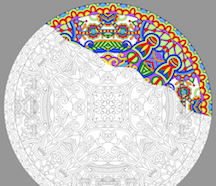
Can coloring reduce anxiety?
Two researchers from Knox College in Illinois tested the effect of a 20 minute coloring session on anxiety levels of 84 students aged between 18 and 22 years. Anxiety levels were measured at three different time points: at the beginning of the experiment, after a brief laboratory-induced anxiety state, and following the coloring session. The participants were divided into three groups: (1) coloring of a mandala design (2) coloring of a simple plaid design and (3) free drawing on a blank page. The results showed a significant reduction in anxiety levels only for the participants of the first two groups, that is, those who colored pre-designed complex patterns. This reduction in anxiety levels was not observed in participants in the “free drawing” condition.
The authors suggest a parallel with the benefits of mindfulness, a practice continuously gaining in interest for its benefits on psychological well-being, emotional regulation, and regulation of stress and anxiety. Thus, the beneficial effects of coloring may result from its ability to focus the individual on the present moment, and on nothing other than the task itself, which does not require much concentration.
That said, even though this technique may reduce feelings of anxiety for some, it is important to remember that there aren’t any universal techniques to help reduce or regulate stress and anxiety. Thus, such a term as “anti-stress” hardly ever applies to everyone. It certainly can be very demanding to try to remain in the present moment when the type of activity does not suit one’s interests or capacities. Can you think of any activity that unmistakably brings you to focus solely on the present moment?




